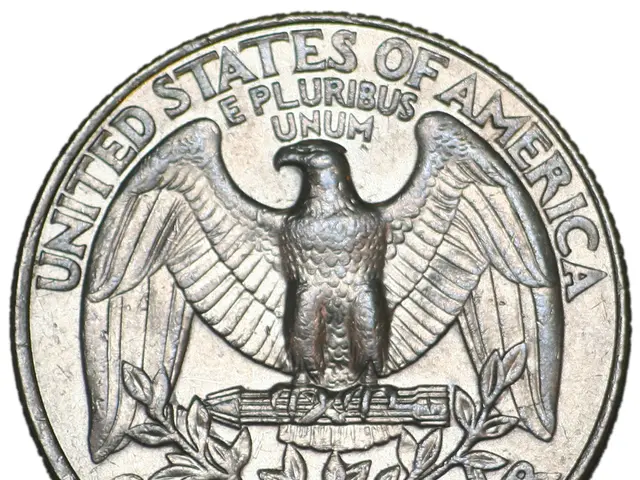Taiwanese currency surges by 6.5% in two days due to trade agreement apprehensions
In a surprising turn of events, Taiwan's currency, the New Taiwan dollar, witnessed its biggest two-day surge in decades, as insurance companies scrambled to protect their US portfolios and markets braced for a potential trade deal with former President Trump. Kicking off another spirited trading session, the currency soared an additional 2.5%, adding to its already impressive 6.5% gain over two days. Since April's start, the currency has seen a nearly 10% rise.
The unexpected currency swings highlight the far-reaching influence of the US-China trade war on the global economy. This currency volatility could pose challenges to Taiwan's export-oriented economy and potentially lead to losses for Taiwanese insurers through their US asset investments.
"Exporters are panicking, local insurers are under-hedged, and equity-related outflows have halted," commented Ju Wang, a strategist at BNP Paribas in Hong Kong.
"The central bank is the only buyer, but it hasn't aggressively supported the market, fueling rumors that currency valuation might be part of the trade talks," Wang continued.
Taiwan's overseas assets, valued at an impressive $1.7 trillion, are predominantly in the form of US bonds – including Treasuries and corporate debt – mostly controlled by life insurers. However, many of these insurers haven't hedged their currency exposure, leaving them vulnerable to losses when the US dollar depreciates. A frantic rush to guard against these risks in a tumbling market could have magnified the currency's advance, analysts suspect.
The currency's upward trend has been bolstered by speculation that a possible trade deal with the US might include measures to fortify the Taiwanese currency and make it less competitive.
In response to these rumors, Taiwan's central bank denied, in a formal statement, that the US Treasury Department had demanded an appreciation in its currency as part of the trade agreement. However, Wang remained skeptical, stating, "Though no economy would publicly admit that currency valuation negotiations are taking place, market sentiments seem to suggest otherwise, especially given Mar-a-Lago's focus on an overvalued US dollar causing trade imbalances."
Given its globally dominant semiconductor sector, Taiwan ranks as the seventh-largest US trading partner. In 2024, it recorded a trade surplus of $74 billion with the US. Trade stocks in TSMC, the world's largest contract semiconductor manufacturer, dropped by 1.3% on the trading day. A weaker US dollar would erode TSMC's profits measured in local currency.
While the recent tariff negotiations between the US and Taiwan, renowned as "frank and cordial" with commitments to bolster economic ties [4], have yet to reveal immediate implications for Taiwan's currency or insurers' US asset holdings, their broader economic ramifications can be assessed:
- Currency Stability: The temporary suspension of Trump's proposed 32% tariffs and progress toward tariff reductions could help decrease trade uncertainties, potentially cushioning the impact on the New Taiwan Dollar (TWD) by boosting investor confidence in export-driven sectors like semiconductors [4][5]. However, specific currency fluctuations weren't noted in the available reports.
- Life Insurers' US Asset Holdings: Although insurers have not been explicitly addressed in the negotiations, Taiwan's promise to expand purchases of US goods (agriculture, defense, energy) and invest in the US economy [3][4] points to the likelihood of insurers continuing their strategy of holding US dollar-denominated assets, such as Treasuries, to hedge currency risks and meet foreign-exchange requirements. However, further news on portfolio adjustments remains to be seen. The lack of direct references to financial markets in the current reports means more developments are needed to fully understand the impacts.
- The sudden surge in the value of the New Taiwan dollar, despite Taiwan's export-oriented economy, could be a result of insurance companies hedging their US portfolios against potential trade deals with the former President Trump.
- Taiwanese insurers, who hold a significant amount of their assets in the form of US bonds, are faced with potential losses due to their under-hedged currency exposure, as the US dollar might depreciate.
- Analysts suspect that the frantic rush to guard against these risks in a tumbling market could have magnified the currency's advance.
- Rumors suggest that the central bank might be part of trade talks, fueled by its seemingly non-aggressive support of the market.
- Taiwan's global standing as the seventh-largest US trading partner, with a significant semiconductor sector, could be affected by a weaker US dollar, potentially eroding TSMC's profits measured in local currency.
- Wang, a strategist at BNP Paribas, remains skeptical about the denial of currency valuation negotiations being part of the trade agreement, citing market sentiments as evidence.
- Given Mar-a-Lago's focus on an overvalued US dollar causing trade imbalances, Wang suggests that no economy would publicly admit currency valuation negotiations, but market sentiments seem to contradict this.
- The ongoing tariff negotiations between the US and Taiwan could have broader economic ramifications, such as the impact on currency stability and the strategy of life insurers holding US dollar-denominated assets to hedge currency risks.








